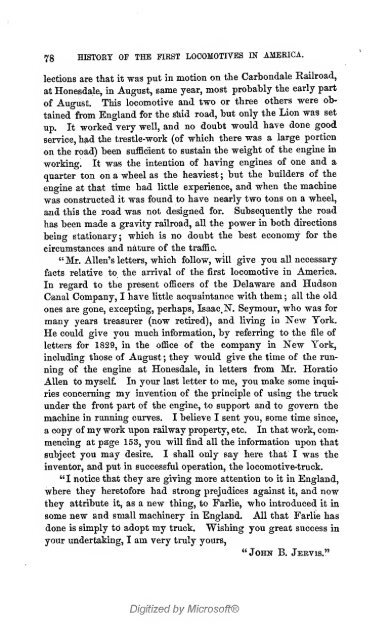The history of the first locomotives in America. From original ...
The history of the first locomotives in America. From original ...
The history of the first locomotives in America. From original ...
You also want an ePaper? Increase the reach of your titles
YUMPU automatically turns print PDFs into web optimized ePapers that Google loves.
78 HISTORY OF THE FIRST LOCOMOTIVES IN AMERICA.<br />
lections are that it was put <strong>in</strong> motion on <strong>the</strong> Carbondale Eailroad,<br />
at Honesdale, <strong>in</strong> August, same year, most probably <strong>the</strong> early part<br />
<strong>of</strong> August. This locomotive and two or three o<strong>the</strong>rs were ob-<br />
ta<strong>in</strong>ed from England for <strong>the</strong> sfeid road, but only <strong>the</strong> Lion was set<br />
up. It worked very well, and no doubt would have done good<br />
service, had <strong>the</strong> trestle-work (<strong>of</strong> which <strong>the</strong>re was a large portion<br />
on <strong>the</strong> road) been sufficient to susta<strong>in</strong> <strong>the</strong> weight <strong>of</strong> <strong>the</strong> eng<strong>in</strong>e <strong>in</strong><br />
work<strong>in</strong>g. It was <strong>the</strong> <strong>in</strong>tention <strong>of</strong> hav<strong>in</strong>g eng<strong>in</strong>es <strong>of</strong> one and a<br />
quarter ton on a wheel as <strong>the</strong> heaviest ; but <strong>the</strong> builders <strong>of</strong> <strong>the</strong><br />
eng<strong>in</strong>e at that time had little experience, and when <strong>the</strong> mach<strong>in</strong>e<br />
was constructed it was found to have nearly two tons on a wheel,<br />
and this <strong>the</strong> road was not designed for. Subsequently <strong>the</strong> road<br />
has been made a gravity railroad, all <strong>the</strong> power <strong>in</strong> both directions<br />
be<strong>in</strong>g stationary; which is no doubt <strong>the</strong> best economy for <strong>the</strong><br />
circumstances and nature <strong>of</strong> <strong>the</strong> traffic.<br />
"Mr. Allen's letters, which follow, will give you all necessary<br />
facts relative to <strong>the</strong> arrival <strong>of</strong> <strong>the</strong> <strong>first</strong> locomotive <strong>in</strong> <strong>America</strong>.<br />
In regard to <strong>the</strong> present <strong>of</strong>ficers <strong>of</strong> <strong>the</strong> Delaware and Hudson<br />
Canal Company, I have little acqua<strong>in</strong>tance with <strong>the</strong>m ; all <strong>the</strong> old<br />
ones are gone, except<strong>in</strong>g, perhaps, Isaac, N. Seymour, who was for<br />
many years treasurer (now retired), and liv<strong>in</strong>g <strong>in</strong> New York.<br />
He could give you much <strong>in</strong>formation, by referr<strong>in</strong>g to <strong>the</strong> file <strong>of</strong><br />
letters for 1829, <strong>in</strong> <strong>the</strong> <strong>of</strong>fice <strong>of</strong> <strong>the</strong> company <strong>in</strong> New York,<br />
<strong>in</strong>clud<strong>in</strong>g those <strong>of</strong> August ; <strong>the</strong>y would give <strong>the</strong> time <strong>of</strong> <strong>the</strong> run-<br />
n<strong>in</strong>g <strong>of</strong> <strong>the</strong> eng<strong>in</strong>e at Honesdale, <strong>in</strong> letters from Mr. Horatio<br />
Allen to myself. In your last letter to me, you make some <strong>in</strong>qui-<br />
ries concern<strong>in</strong>g my <strong>in</strong>vention <strong>of</strong> <strong>the</strong> pr<strong>in</strong>ciple <strong>of</strong> us<strong>in</strong>g <strong>the</strong> truck<br />
under <strong>the</strong> front part <strong>of</strong> <strong>the</strong> eng<strong>in</strong>e, to support and to govern <strong>the</strong><br />
mach<strong>in</strong>e <strong>in</strong> runn<strong>in</strong>g curves. I believe I sent you, gome time s<strong>in</strong>ce,<br />
a copy <strong>of</strong> my work iipon railway property, etc. In that work, commenc<strong>in</strong>g<br />
at page 153, you will f<strong>in</strong>d all <strong>the</strong> <strong>in</strong>formation upon that<br />
subject you may desire. I shall only say here that I was <strong>the</strong><br />
<strong>in</strong>ventor, and put <strong>in</strong> successful operation, <strong>the</strong> locomotivfr-truck.<br />
" I notice that <strong>the</strong>y are giv<strong>in</strong>g more attention to it <strong>in</strong> England,<br />
where <strong>the</strong>y heret<strong>of</strong>ore had strong prejudices aga<strong>in</strong>st it, and now<br />
<strong>the</strong>y attribute it, as a new th<strong>in</strong>g, to Farlie, who <strong>in</strong>troduced it <strong>in</strong><br />
some new and small mach<strong>in</strong>ery <strong>in</strong> England. All that Farlie has<br />
done is simply tO adopt my truck. Wish<strong>in</strong>g you great success <strong>in</strong><br />
your undertak<strong>in</strong>g, I am very truly yours,<br />
Digitized by Micros<strong>of</strong>t®<br />
"John B. Jekvis."
















